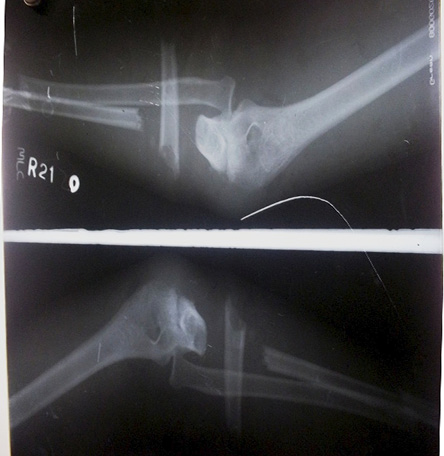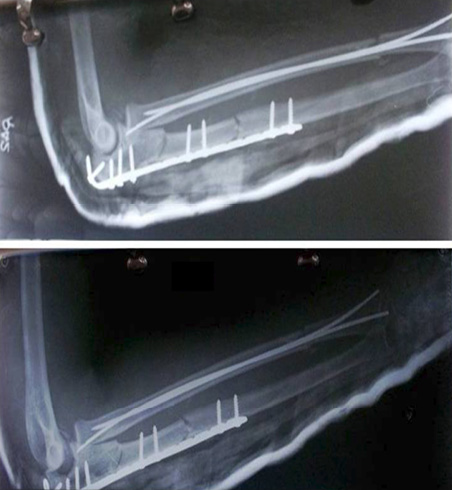A 42-year-old migratory laborer presented to the emergency department with an alleged history of being hit by a bull on his right forearm and a subsequent fall. On examination, he had a compound fracture with a small bleeding wound (2 × 1.5 cm) over the postero-medial upper part of the forearm and a part of broken bone protruding through it. There was diffuse tenderness, swelling tenderness, and bony crepitus felt. There was no distal neurovascular deficit. Radiographs of his right arm and forearm with shoulder, elbow, and wrist joints revealed a segmental fracture of the proximal ulna at the upper part along with anterior radial head dislocation. There was an associated distal radius fracture ipsilaterally [Figure 1]. Under general anesthesia, using the dorsal approach, the wound was thoroughly debrided. In the same sitting internal fixation with a contoured plate of ulna, reduction of radial head, and closed fixation of the distal radius fracture was done using square nails. Postoperatively, the forearm was immobilized in an above elbow slab in 100 degrees of flexion [Figure 2]. The sutures were removed at two weeks and recovery was uneventful. At six weeks, physiotherapy with range of movement was started and the patient was moved back to his original place and lost to follow-up.

Figure 1: Preoperative X-ray showing the unusual fracture pattern with segmental ulna fracture, radial head dislocation, and radial shaft fracture.

Figure 2: Postoperative X-ray showing fixation of radius and ulna with reduced radial head.
Question
- What is the type of injury?
a. Monteggia fracture-dislocation.
b. Monteggia variant.
c. Galeazzi fracture-dislocation.
d. Double blow injury (Monteggia and distal radius fracture pattern).
Answer
d. Double blow injury (Monteggia and distal radius fracture pattern).
Discussion
Monteggia fracture-dislocation is a rare injury seen in adult and children comprising 1–2% of forearm injuries.1,2 The mechanism of injury is always a fall on an outstretched hand with a pronated position. The fracture pattern in adults have a transverse/butterfly ulnar fracture associated with radial head dislocation and universally identified using the Bado classification. However, certain variants or equivalents have also been described in relation to the fracture pattern of ulnar bone.3 A lesion like ours with segmental ulna has not been previously described, and this is because of the peculiar mechanism of injury in our case. Nevertheless, Monteggia and its variants are associated with a combination of ulnar fracture, radiohumeral dislocation, ulnohumeral dislocation, proximal radioulnar dislocation, radial fracture and distal radioulnar joint/interosseous membrane lesion.4 The complexity of this combination can explain the confusion in classification and treatment. Galeazzi fracture is also a rare unstable injury of the forearm compromising 3–4% of cases.5 Four radiological criteria of distal radioulnar joint disruption (DRUJ) have been identified, which includes a fracture of the basal ulnar styloid; on an anteroposterior X-ray widening of the DRUJ; on a lateral view, dislocation of the radius relative to the ulna; and finally, a shortening of the radius of > 5 mm.6 There are only a handful of reports having Monteggia and Galeazzi fracture-dislocation in the same patient and few reports of Monteggia and distal radius fractures.7–9 We did not document DRUJ dislocation component as per Moore criterion and the patient being a migratory laborer never returned. The Monteggia variant is unique and authors feel that the imaging of this ‘rare of a rare’ fracture pattern is worth sharing with the orthopedics community, particularly students.
Disclosure
The authors declared no conflicts of interest.
references
- Williams HL, Madhusudhan TR, Sinha A. Type III monteggia injury with ipsilateral type II Salter Harris injury of the distal radius and ulna in a child: a case report. BMC Res Notes 2014 Mar;7:156.
- 2. Sajjan SS, Hegde AS, Annappa R, Mallya S. Monteggia type 1 fracture equivalent with concomitant ipsilateral distal radius and ulna fracture in an adult: a rare case report. J Clin Diagn Res 2017;11(10):RD06-RD07.
- 3. Josten C, Freitag S. Monteggia and monteggia-like-lesions: classification, indication, and techniques in operative treatment. Eur J Trauma Emerg Surg 2009 Jun;35(3):296-304.
- 4. Giannicola G, Sacchetti FM, Greco A, Cinotti G, Postacchini F. Management of complex elbow instability. Musculoskelet Surg 2010 May;94(Suppl 1):S25-S36.
- 5. Mikić ZD. Galeazzi fracture-dislocations. J Bone Joint Surg Am 1975 Dec;57(8):1071-1080.
- 6. Moore TM, Klein JP, Patzakis MJ, Harvey JP Jr. Results of compression-plating of closed galeazzi fractures. J Bone Joint Surg Am 1985 Sep;67(7):1015-1021.
- 7. Nihar RP, Poonam P. Ipsilateral combined monteggia and galeazzi injuries presenting late: a case report. Inj Extra 2005;36(10):458-462.
- 8. Maeda H, Yoshida K, Doi R, Omori O. Combined monteggia and galeazzifractures in a child: a case report and review of the literature. J Orthop Trauma 2003 Feb;17(2):128-131.
- 9. Boopalan PR, Titus VT, Jepegnanam TS, Daniel A, Chittaranjan S. Ipsilateral galeazzi and monteggia fracture. Inj Extra 2007;38(9):308-311.